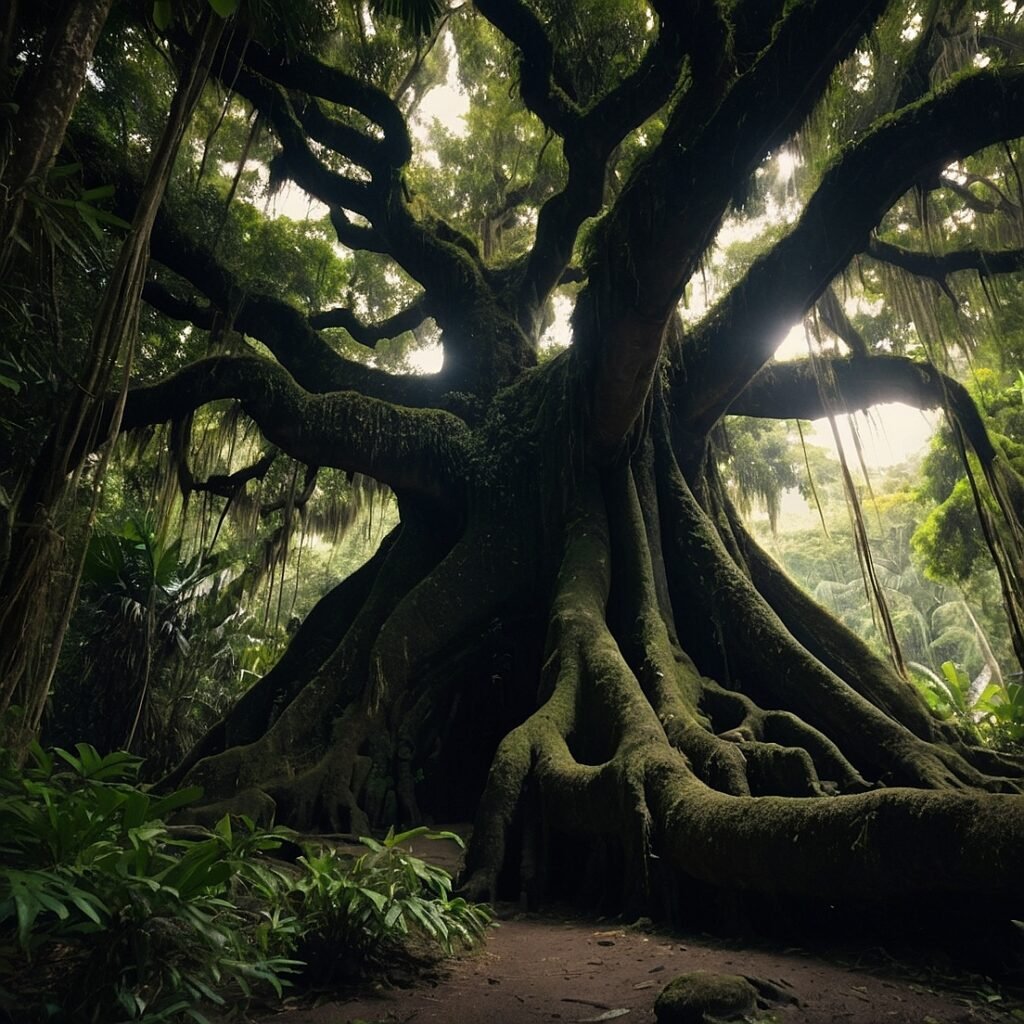Have you ever walked through a dense, tropical forest and felt an inexplicable chill run down your spine? As if the very air around you was charged with an ancient, mysterious energy? In the lush landscapes of the Philippines, there’s one tree that embodies this feeling more than any other – the enigmatic Balete tree.
As a nature enthusiast and folklore lover, I’ve always been drawn to the stories that surround these magnificent botanical wonders. The Balete tree isn’t just a plant; it’s a living legend, a cornerstone of Philippine mythology, and a subject of both fascination and fear for generations of Filipinos. Join me as we unravel the secrets of this mystical giant and explore why it has earned such a dark reputation in Philippine culture.
The Balete Tree: Nature’s Haunted House
What exactly is a Balete tree?
The Balete tree, scientifically known as Ficus balete, is a species of strangler fig native to the Philippines and other parts of Southeast Asia. But don’t let its scientific classification fool you – this is no ordinary tree. The Balete starts its life as an epiphyte, growing on other trees or structures. As it matures, it sends down aerial roots that eventually envelop its host, creating a complex network of woody tendrils that give it an otherworldly appearance.
It’s not hard to see why the Balete has captured the imagination of the Filipino people. Its gnarled trunk, sprawling aerial roots, and imposing size make it look like something straight out of a fantasy novel. In many ways, the Balete is nature’s own haunted house, with its twisted form providing the perfect backdrop for ghost stories and supernatural tales.
A tree of many names
The Balete tree goes by many names across the Philippines, each one hinting at its mystical reputation:
| Local Name | Meaning/Origin |
|---|---|
| Baliti | Tagalog name |
| Nonok | Ilocano name |
| Salaguimanog | Bicolano name |
| Balete | Most common name used in English |
No matter what you call it, one thing remains constant – the air of mystery that surrounds this remarkable tree.
The Dark Legends of the Balete
A home for supernatural beings
In Philippine folklore, the Balete tree is much more than just a plant – it’s a gateway between the world of the living and the realm of the supernatural. Many Filipinos believe that these trees are the dwelling places of various mythical creatures and spirits. Some of the most common inhabitants said to reside in or around Balete trees include:
| Supernatural Being | Description |
|---|---|
| Kapre | A tall, dark, cigar-smoking giant |
| Tikbalang | A creature with the head of a horse and the body of a man |
| Diwata | Ethereal nature spirits or fairies |
| Engkanto | Handsome or beautiful environmental spirits |
| White Lady | The ghost of a woman in white |
Growing up in the Philippines, I’ve heard countless stories from elders about encounters with these beings near Balete trees. While I’ve never personally seen a Kapre or Tikbalang (thankfully!), the conviction in the storytellers’ voices always sent shivers down my spine.
The tree that demands respect
One of the most pervasive beliefs about the Balete tree is that it demands respect from humans. Many Filipinos, especially in rural areas, still practice certain customs when passing by a Balete tree. These may include:
- Saying “tabi-tabi po” (excuse me) to ask permission from the spirits to pass by
- Avoiding urinating near the tree
- Not cutting down or damaging the tree
- Offering small gifts or food to appease the spirits
I remember my grandmother always insisting that we say “tabi-tabi po” whenever we passed a large Balete tree during our trips to the province. At the time, I thought it was just a quaint custom, but now I appreciate the deep respect for nature and the unseen world that it represents.
The Science Behind the Superstition
A botanical marvel
While the supernatural tales surrounding the Balete tree are fascinating, the reality of this plant is no less impressive. As a strangler fig, the Balete has a unique life cycle that contributes to its eerie appearance:
- The tree starts as a seed deposited on a host tree by birds or other animals.
- It grows as an epiphyte, drawing nutrients from the air and rain.
- As it matures, it sends down aerial roots that eventually reach the ground.
- These roots thicken and intertwine, gradually enclosing the host tree.
- Over time, the host tree may die, leaving the Balete as a hollow, freestanding structure.
This growth pattern results in the tree’s distinctive appearance, with its hollow trunk and network of aerial roots creating natural hiding spots and caverns. It’s easy to see how these features could spark the imagination and give rise to stories of supernatural inhabitants.
An ecosystem in itself
The Balete tree isn’t just a single plant – it’s an entire ecosystem. Its complex structure provides habitats for a wide variety of plants and animals:
| Organism | Relationship with Balete |
|---|---|
| Epiphytes | Grow on the tree’s branches and trunk |
| Birds | Nest in the tree’s cavities and feed on its fruit |
| Bats | Roost in the tree’s hollows and disperse its seeds |
| Insects | Live in and feed on various parts of the tree |
| Fungi | Grow on the tree’s bark and fallen leaves |
This rich biodiversity contributes to the tree’s mystical aura. The rustling of leaves, the chirping of birds, and the movement of small animals within the tree’s structure can easily be interpreted as the activities of supernatural beings by those predisposed to such beliefs.
The Balete in Philippine Culture
A symbol of resilience
Despite its dark reputation, the Balete tree holds a special place in Philippine culture. In many ways, it symbolizes the resilience and adaptability of the Filipino people. Just as the Balete starts life in adverse conditions and grows to become a mighty tree, Filipinos have faced numerous challenges throughout history and emerged stronger.
The tree’s ability to thrive in various environments – from dense forests to urban areas – mirrors the Filipino diaspora, with people from the Philippines making homes and building communities around the world while maintaining their cultural identity.
A source of inspiration
The Balete tree has inspired countless works of art, literature, and popular culture in the Philippines:
- It’s a common subject in traditional and contemporary Filipino paintings.
- Many Filipino horror movies and TV shows feature the Balete tree as a key element.
- Filipino writers often use the Balete as a symbol or setting in their stories.
- Some modern Filipino designers incorporate Balete-inspired elements in their work.
I’ve always been amazed by how a single tree species can have such a profound impact on a nation’s cultural output. It’s a testament to the power of nature to shape our imaginations and beliefs.
Conservation and Modern Challenges
Threats to the Balete
Despite its cultural significance and ecological importance, the Balete tree faces several threats in the modern world:
- Deforestation: As forests are cleared for agriculture and development, many old Balete trees are lost.
- Urban expansion: In cities, large Balete trees are sometimes removed to make way for buildings and roads.
- Climate change: Altering weather patterns may affect the Balete’s growth and distribution.
- Loss of traditional knowledge: As younger generations move away from rural areas, traditional beliefs about respecting the Balete may be forgotten.
It’s a sad irony that a tree known for its strength and resilience is now vulnerable to human activities. As someone who values both nature and cultural heritage, I find this situation particularly troubling.
Conservation efforts
Fortunately, there are efforts underway to protect and preserve Balete trees:
| Conservation Measure | Description |
|---|---|
| Legal protection | Some local governments have passed ordinances protecting large or old Balete trees |
| Urban greening | Incorporation of Balete trees in urban landscaping projects |
| Ecotourism | Promotion of notable Balete trees as tourist attractions |
| Education | Programs to teach younger generations about the ecological and cultural importance of the Balete |
These initiatives give me hope that future generations will still have the opportunity to marvel at these magnificent trees and learn about their rich cultural significance.
The Balete Tree in the Modern World
A bridge between past and present
In our rapidly changing world, the Balete tree serves as a living link to the Philippines’ rich cultural heritage. It reminds us of the deep connection our ancestors had with nature and the spiritual world. At the same time, it challenges us to consider how we can maintain these connections in the face of modernization and urbanization.
I’ve noticed that even in bustling cities like Manila, people still pause and show respect when they encounter a large Balete tree. It’s a beautiful moment of tradition persisting in the midst of progress.
A lesson in coexistence
The Balete tree also offers us a powerful lesson in coexistence. Just as the tree provides a home for countless organisms, from tiny insects to large birds, perhaps we too can learn to create societies where diverse beliefs and traditions can thrive side by side.
In my travels around the Philippines, I’ve seen Balete trees that are simultaneously revered as dwelling places of spirits, protected as important parts of the ecosystem, and appreciated as beautiful natural monuments. This multifaceted approach to a single tree species shows how we can value something from multiple perspectives without conflict.
The Enduring Mystery of the Balete
As we’ve explored the world of the Balete tree, we’ve uncovered a rich tapestry of folklore, science, and cultural significance. From its unique biology to its central role in Philippine mythology, the Balete continues to captivate and intrigue.
While we may never know for sure if Kapre really smoke cigars in its branches or if Diwata dance beneath its canopy, one thing is certain – the Balete tree will continue to be a source of wonder and inspiration for generations to come. Whether you see it as a majestic work of nature, a habitat for diverse wildlife, or a gateway to the supernatural realm, the Balete invites us all to pause, reflect, and perhaps whisper a respectful “tabi-tabi po” as we pass by.
I encourage you to share your own experiences with Balete trees or similar legendary plants from your culture. Have you ever encountered a tree that gave you an unexplainable feeling? Or do you have a favorite local legend about a particular plant or place in nature? Let’s keep these fascinating stories alive by sharing them with each other.
Disclaimer: This article is based on Philippine folklore, cultural beliefs, and scientific information available up to 2016. While every effort has been made to ensure accuracy, some details may have changed since then. If you notice any inaccuracies, please report them so we can correct them promptly.




